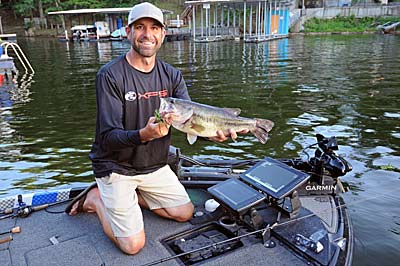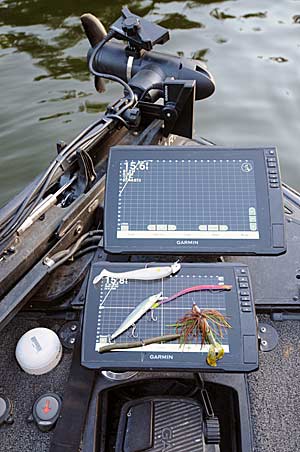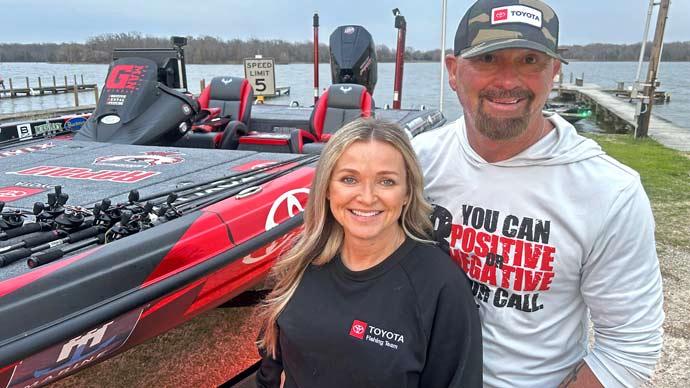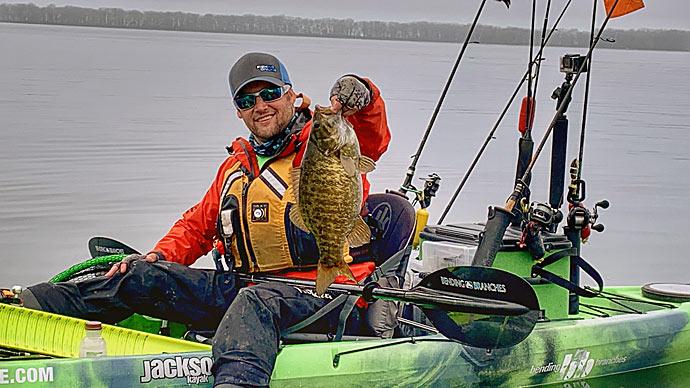
His Garmin unit’s screen comes alive when Casey Scanlon fishes for summertime bass.
The Bassmaster Opens competitor knows bass are active and "pretty grouped up" in the summertime, so he can easily spot him with his Garmin Echomap Ultra 2 126sv unit paired with the Garmin Livescope LVS 34 transducer. “During different days, conditions due to current or overcast or sunny skies cause the fish to position differently, so the forward facing sonar allows you to target those fish at the different depth ranges they are sitting at,” Scanlon says.
Scanlon considers the Livescope LVS34 transducer best for tracking bass because it projects a wider cone for better accuracy and clarity. "You can really find your bait a lot easier on this transducer than previous ones,” he says. "Seeing your bait in relation to the fish and putting it right in front of them is key, and it gives you a lot more confidence when you see your bait throughout the presentation."
The 2013 Bassmaster Classic qualifier usually tinkers with only a few forward-facing sonar (FFS) settings on his Garmin unit. “No matter what time of the year it is, I pretty much play with the gain on my unit," he says. “I use a lot of the factory settings, but I will take the range and the depth off of factory settings. I will go plus or minus with the gain depending on the clarity of the lake and different things like that. I try turning up the gain as much as possible until it gets my screen fuzzy." He suggests that the higher you turn up the gain, the brighter your returns on the screen will be and the better your chance of seeing your lure.
Scanlon usually sets his range at 100 feet, which he thinks that with a "decent cast," he can see his lure when it lands. However, he notices that at a range of 80 feet, he seems to outcast the beam, and at a range of 120 feet, it lacks clarity.
The Missouri guide changes his depth range throughout the day depending on the bottom depth. If his boat is sitting over 20 feet of water, Scanlon sets the depth range at 25 feet; if the boat is over 15 feet of water, he will set the depth range at 20 feet. “I want to see the bottom, but I don't want the bottom to take up a lot of my screen,” he says.
Once he has his settings in order, Scanlon relies on the following five lures that show up best on his FFS.
Jig
“I love a jig because I can control its depth,” he says. “I can fish from 0 foot out to as deep as I want to.” Scanlon selects a 5/8-ounce jig, which has good action when falling or swimming through suspended bass and falls fast to reach bottom-hugging bass. He suggests the jig with a full skirt and large trailer is ideal for FFS because it delivers a good return on his electronics.

His FFS allows Scanlon to present precisely to suspended or bottom-hugging bass. “I like to put the jig directly on the bass,” Scanlon says. “So if the fish are suspended up in the water column, I want to drop the jig right on top of their heads and let it fall right in front of them to see if they track it down to the bottom. For suspended fish, I also try to swim it over their heads to get their attention.”
Neko-Rigged Stickworm
When he wants to watch a slower falling presentation with FFS, Scanlon wacky-rigs a 5 3/8-inch Bass Pro Shops Stik-O Worm on a 1/0 Hayabusa Fluorocarbon Wacky Hook with a 1/16- or 1/32-ounce Bass Pro Shops Tungsten Nail Weight stuck in one end of the worm. The rig produces both suspended bass and bass on the bottom.
“I try to keep the rig above the bass and not let it sink below them too much,” Scanlon says. “I am basically judging the fish almost like you would sight fishing—seeing if they react to it falling past them or if I am using a shaking technique and bringing it over the top of their heads.”
Drop Shot Worm

The drop shot allows Scanlon to watch a vertical or horizontal finesse presentation with FFS. He notices on his screen that the drop shot rig draws many strikes on the fall. For his drop shot rig, he favors a 6-inch Roboworm Straight Tail Worm on a 1/0 Hayabusa FPP Straight Hook or the Bass Pro Shops Stik-O on a 2/0 hook with a 3/8- or ¼-ounce weight. Scanlon notes that the combination of the worm and the weight makes the rig easy to detect with FFS.
The drop shot rig's fast fall allows Scanlon to place the lure in front of a bass at any depth. “I can put that bait on bass, especially if they are on the bottom or around cover before the fish move,” he says.
When watching suspended bass with FFS, Scanlon drops his rig straight down to the same depth as the bass and holds it in front of them. If he sees bottom-hugging bass on his FFS, Scanlon drops the rig all the way to the bottom and drags the drop shot, similar to a Carolina rig retrieve.
Jerkbait
The 2012 Bassmaster Table Rock Lake Open winner discloses he always has a suspending jerkbait tied on whenever he is fishing with FFS. "It shows up really well on the forward-facing sonar because you are moving it a lot so you can track it on the screen, and it calls fish from a really, really long distance,” Scanlon says. “I never really realized that until I saw it on forward-facing sonar."
The Bass Pro Shops XPS Staredown and Megabass Vision 110 are Scanlon’s jerkbait choices for FFS. He tracks summertime bass that are roaming around in packs chasing baitfish high in the water column and jerks the stickbaits with a high-speed retrieve.
When his FFS shows a bass following his lure, Scanlon keeps jerking it fast because he notices the fish will turn away from the lure if he stops it. Scanlon has seen bass follow his lures a couple of times before hitting the lure, so he makes multiple casts to the schooling fish.
Swimbait
A 5- or 6-inch swimbait with a 1/2- or 3/4-ounce jighead projects a large profile, which helps Scanlon track his lure more easily on FFS.
The swimbait's slow, steady retrieve entices either suspended or bottom-hugging bass. " I want to keep the bait moving fast enough to keep the fish interested," Scanlon says. Scanlon changes his retrieve if he sees bass on his FFS chasing the bait but not closing in on it. "I usually try to speed up my retrieve, or if I see them losing interest in it and following it slower, I will speed the bait away from them and make another cast before they follow it too far away from the original area that I was casting to them." Scanlon will make a follow-up cast with the Neko rig if the bass follows the swimbait close to the boat but turns away.




